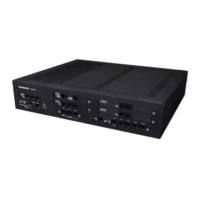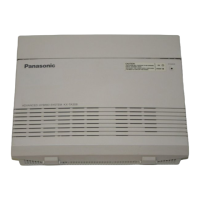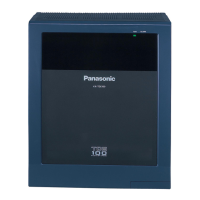17.1 PBX Configuration—[9-1] Private Network—
TIE Table
A TIE line is a privately leased communication line between two or more PBXs, which provides cost effective
communications between company members at different locations.
A maximum of 32 TIE Line Routing and Modification Tables can be programmed. It is necessary to make
unified tables with all PBXs at different locations in a TIE line network in order to identify the trunk route to
be used when an extension makes or receives a TIE line call.
There are two types of routing methods: the Extension Number Method, where all extensions in the network
are given a unique extension number; and the PBX Code Method, where each PBX is given a unique code,
which is dialled before the extension number to call an extension at another PBX.
Two priority sets (from a total of 8) are displayed at a time. To display other priority sets, click the applicable
tab.
Using a private network, up to 8 PBXs can share one voice mail system (centralised VM) connected to
another PBX. This can provide voice mail for extensions attached to any of the PBXs in the network.
Name Description Value Range Links
Own PBX
Code
Specifies the PBX code of the local PBX,
when using PBX Code Method numbering on
a TIE line network. If this cell is left empty,
the Extension Number Method is used.
Max. 7 digits
(consisting of 0–9)
Feature Manual
References
4.3.1 TIE Line
Service
Priority 1–Priority 8
Name Description Value Range Links
Leading
Number
Specifies the leading number for
other PBX extension numbers or the
PBX code of others in the TIE line
network.
Max. 3 digits
(consisting of 0–9, *,
and #)
Feature Manual
References
4.3.1 TIE Line Service
Removed
Number of
Digits
Specifies the number of leading digits
of the dialled number to be removed
for each priority.
0–15
Feature Manual
References
4.3.1 TIE Line Service
Added
Number
Specifies the number to be added to
the dialled number in place of the
removed digits for each priority.
Max. 32 digits
(consisting of 0–9, *,
#, and P [Pause])
Feature Manual
References
4.3.1 TIE Line Service
Trunk Group Specifies the trunk group to be used
for TIE line calls for each priority.
None, 1–64
Feature Manual
References
4.3.1 TIE Line Service
Enhanced QSIG
Name Description Value Range Links
Leading Number Specifies the leading number for other
PBX extension numbers or the PBX
code of other PBXs in the TIE line
network.
Max. 3 digits
(consisting of 0–9,
*, and #)
Feature Manual
References
4.3.5 QSIG Enhanced
Features
17.1 PBX Configuration—[9-1] Private Network—TIE Table
528 PC Programming Manual

